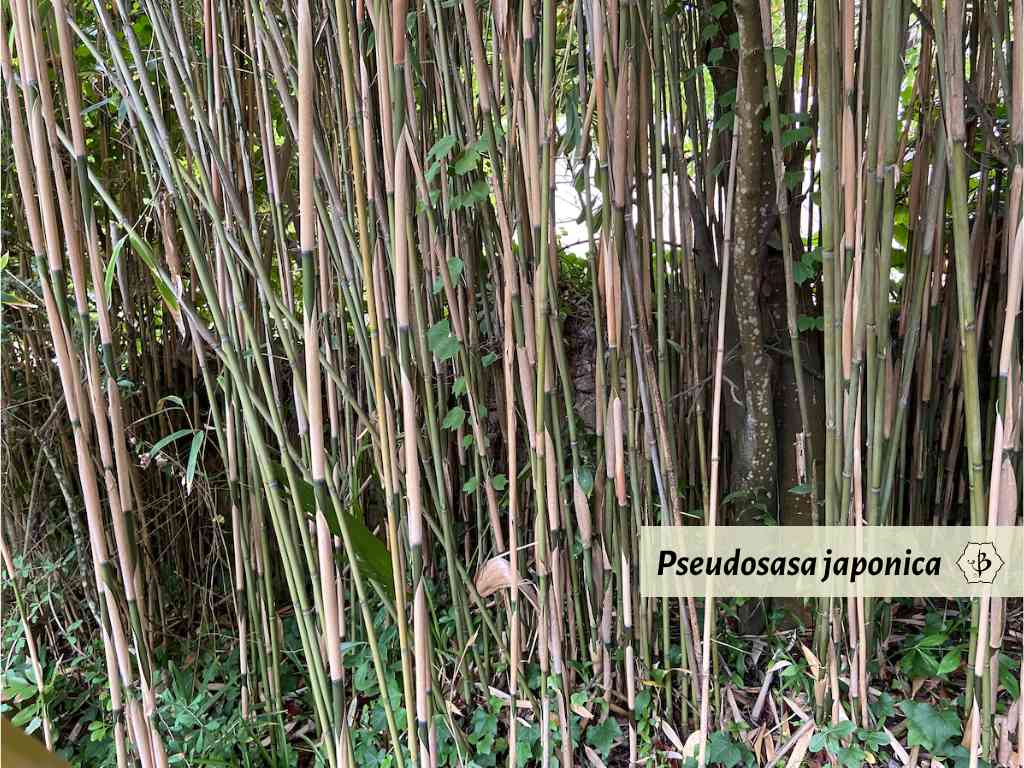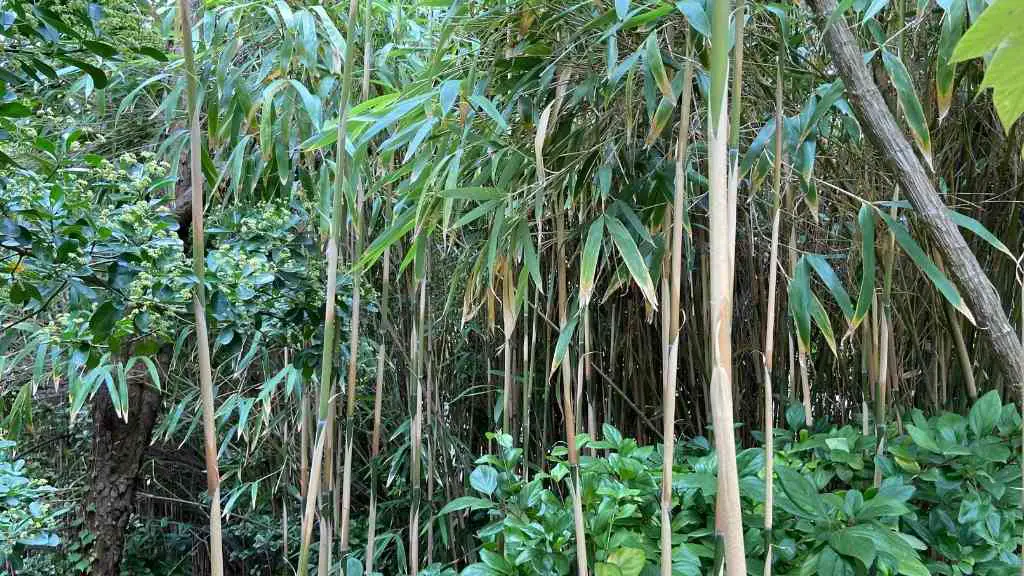Let’s get straight to the point. Arrow Bamboo is simply one of our favorite species of ornamental bamboo. If you’re maintaining a residential garden, Pseudosasa japonica is an excellent choice as a manageable, attractive, medium-sized plant, suitable for a wide variety of conditions. But before you plant a beautiful grove of Arrow Bamboo, you should be aware of all its virtues, requirements, and limitations.
Pseudosasa japonica is the botanical name of Arrow Bamboo, a species native to Japan and Korea. This medium-sized bamboo is a runner but has a more compact growth habit than many running bamboo varieties. Its thin, tightly clustered culms make Arrow Bamboo ideal as a privacy hedge, reaching 10-20 feet in height. The plant is very shade tolerant and can withstand freezing temperatures as low as 5 or 10º F. Less tolerant of drought, this bamboo requires regular watering.
This article — first published in October 2021 and last updated in March 2024 — is part of an ongoing series about different types and species of bamboo. To learn more about this fascinating and diverse collection of grasses, check out some of these other articles.
- Running bamboo vs Clumping bamboo
- Bambusa oldhamii: Chinese timber bamboo
- Black bamboo
- Golden bamboo
- Pseudosasa amabilis: Tonkin bamboo
- Sasa kurilensis: Russian bamboo
- Semiarundinaria fastuosa: Temple bamboo
- Native bamboos of North America: Genus Arundinaria

Characteristics of Arrow Bamboo
Arrow Bamboo takes its common name from the fact that Samurai warriors historically selected this species for the thin, straight poles, ideal for use as arrows and spears. The erect, dark green canes of this bamboo look even more elegant standing upright in the garden than they do sailing through the air over a battlefield.
Today, we seldom see bamboo being used as a weapon. At least not in my social circles. But the plant does have a number of other virtuous qualities.
Depending on your growing conditions, Arrow Bamboo can grow to between 10 and 20 feet tall. Thin culms are usually about one-half to one inch in thickness. They sometimes arch gently and gracefully at the top. As such, this bamboo does not lend itself to building and construction. But it is sturdy enough for small, lightweight crafts.
It’s especially important to know that this is a running bamboo species. But unlike many species of Phyllostachys and other runners, Arrow Bamboo is far less prone to becoming invasive. Even so, it’s always wise to use a rhizome barrier around a running bamboo.
Arrow Bamboo also has larger than average leaves, which some authors have compared to arrows. They can grow up to 10 or 12 inches long and 1-1.5 inches wide. They also tend to have a deep green color with a shiny, polished aspect.
As the culms and leaves both grow densely together, the tight thickets of Pseudosasa japonica provide an excellent privacy hedge or living fence. But the lowest few feet of these bamboo culms have little or no foliage, so you might only expect partial privacy.

Growing Conditions for Arrow Bamboo
Native to Japan and Korea, Pseudosasa japonica is a temperate bamboo that is cold hardy to well below freezing. It can typically survive weather down to 5 or 10º F. USDA zones 7 through 10 will have the best conditions for this species.
For added protection in the severe winter, it’s a good idea to layer some mulch around the grove. Wood chips, grass cuttings, or dried leaves usually work best. This helps to protect the roots from freezing and also to retain moisture in the soil.
Arrow bamboo is tolerant of salty air and wind, making it a good choice in coastal areas. But one thing it’s less fond of is drought. Arrow Bamboo needs regular water, especially in the summer. Try to keep the soil moist, but don’t let it stay soggy.
This is also a great choice of bamboo for shady areas. Partial shade is great, and consider providing extra shade if you’re gardening in a particularly warm climate. Arrow Bamboo is ideal as a secondary canopy, beneath a taller, shade-giving tree, or under a large grove of timber bamboo. It grows well in a pot, too, better than most other types of bamboo.
In a mild climate with ample water, this species should thrive and flourish. But in order to prevent it from becoming overly successful, it’s important to have some sort of containment strategy. As with any running bamboo, you will want to install a rhizome barrier or dig a containment trench to keep the grove in place.
As a native species of Japan, Arrow Bamboo is an especially apt choice for planting in a Japanese garden. Its medium stature makes it a fine companion with smaller dwarf bamboo and taller timber bamboo.
Next in Line
If you enjoyed learning about Arrow Bamboo, please consider sharing the article and subscribing to our blog. You might also enjoy more of our in-depth articles about the many uses and benefits of bamboo.
- Best bamboo species for the shade
- Best bamboo species for pots and containers
- Growing bamboo in zones 7 and 8
- 10 Best bamboo species for your garden
FEATURE PHOTO: Pseudosasa japonica, or Arrow Bamboo, growing in a botanical garden in Paris. Photo by Fred Hornaday.


























I am from India -Manipur (Imphal) I want a plant of pseudosasa japonica bamboo can you ship me a plant of this bamboo in my place
Sorry sir, but live plants cannot be shipped internationally.
who told you Fred ??
Live plants cannot be shipped because they will be held in customs for weeks or months. During this waiting period, most or all young plants will surely die.
So, we cant bring Bamboo sapling from another country to Europe ?
Order seeds from Lihua or buy plants from Bambu Parque in Europe. Within the EU is not a problem. If the species grows well in Europe, they will have it at Bambu Parque.